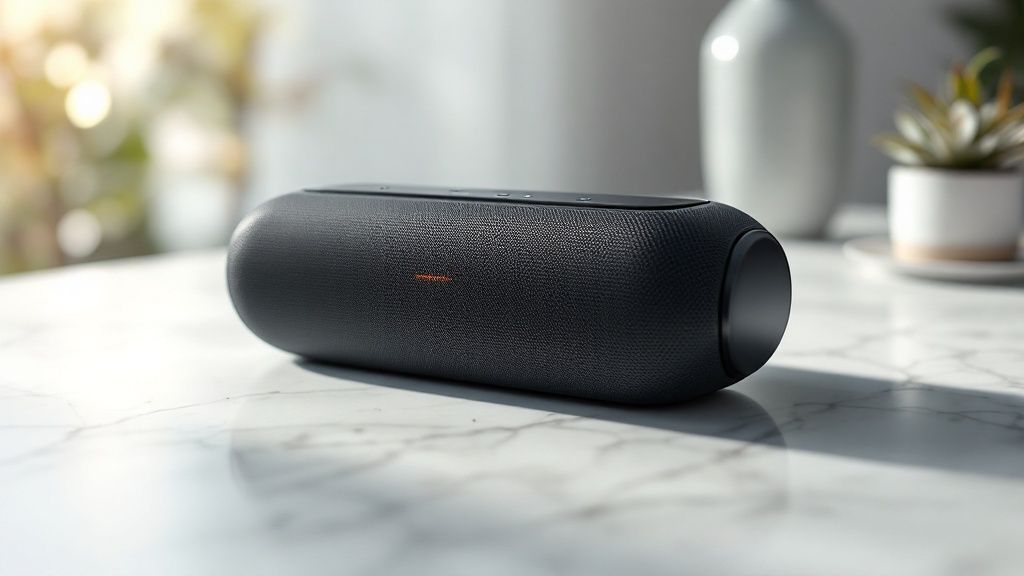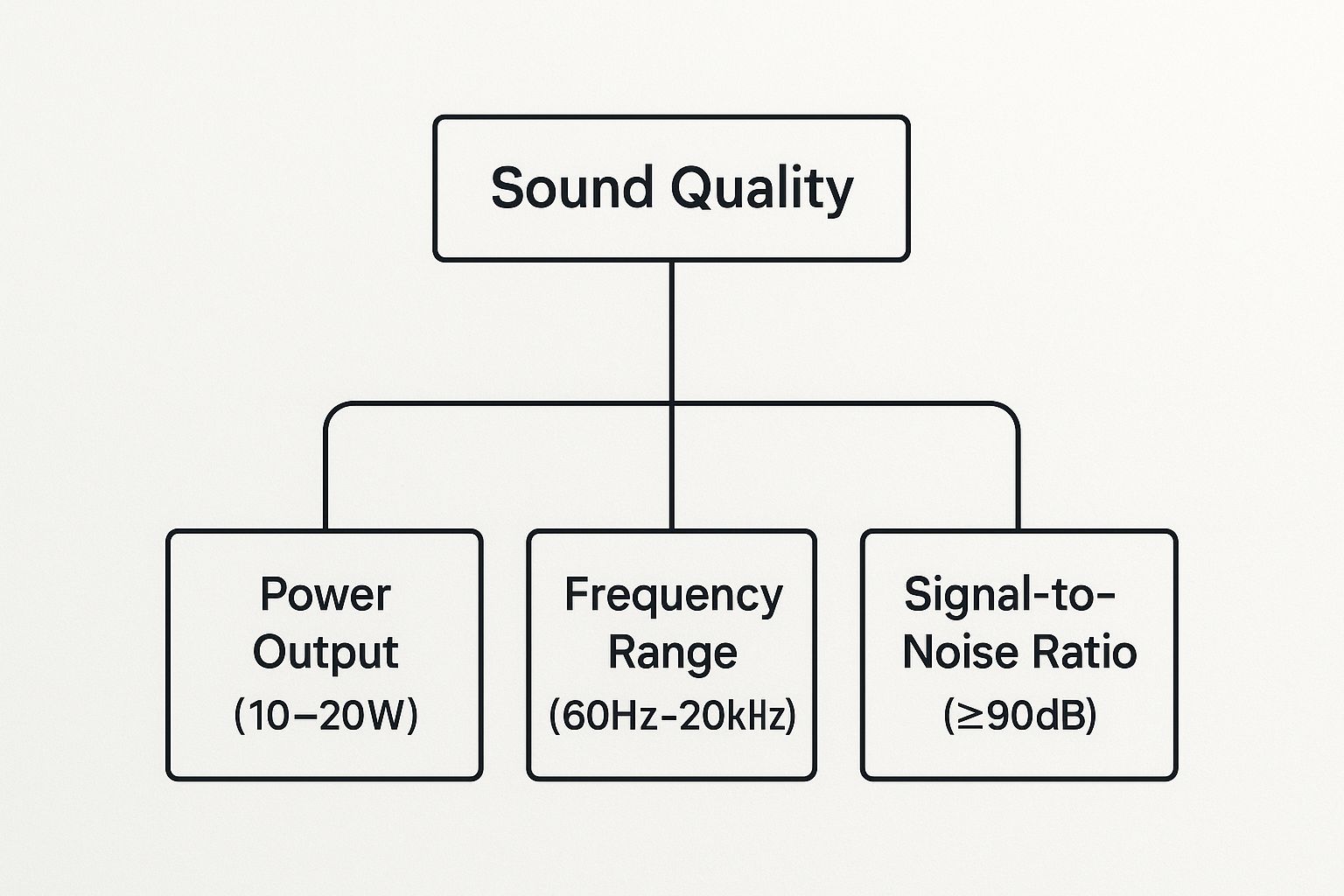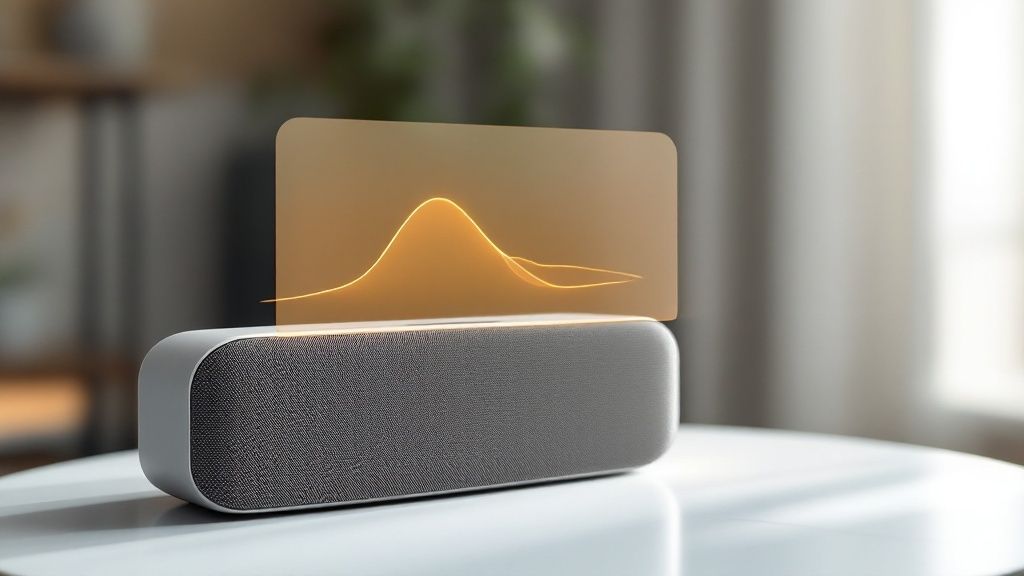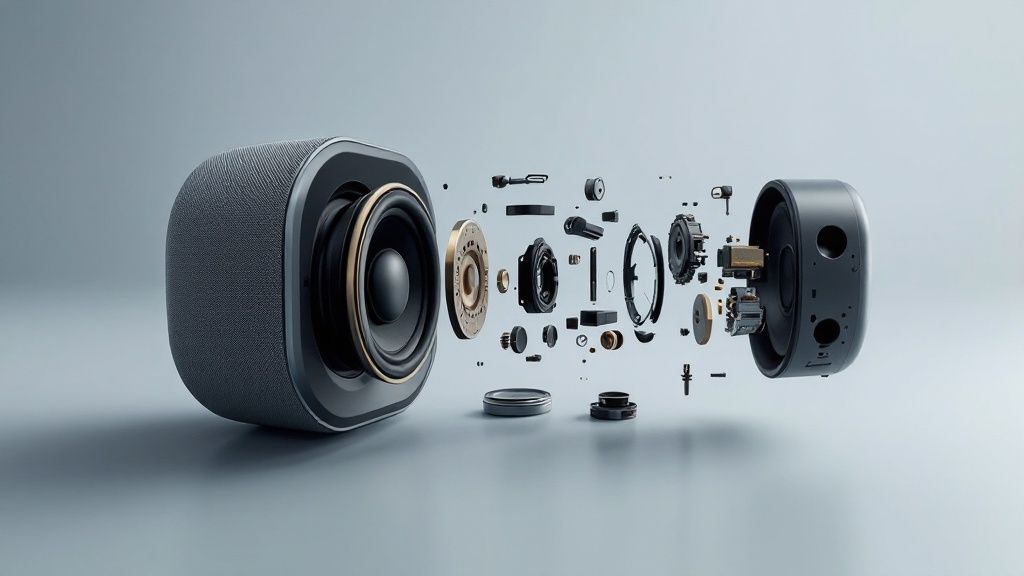Ever wonder why one little speaker can fill a room with punchy, detailed music, while another one just sounds… meh? It's not magic, and it's definitely not just about size. The secret is in the interplay between the speaker's guts—its physical hardware—and the digital smarts that feed it the music.
What Really Makes a Bluetooth Speaker Sound Great

Think of a great speaker like a chef's kitchen. You need top-notch ingredients (the digital audio file) and a skilled chef with fantastic equipment (the speaker's hardware) to turn them into a masterpiece. If either one is lacking, you get a disappointing meal.
It all starts with the drivers. These are the cone-shaped parts that actually move back and forth to create the sound waves you hear. Their size and quality are a huge deal. Bigger drivers can push more air, which is exactly what you need for that satisfying, deep bass that you can feel. On the other end, smaller, specialized drivers called tweeters handle the crisp, sparkly high notes in cymbals and vocals.
The Digital Handshake: Audio Codecs
But before the drivers can do their thing, the music has to get from your phone to the speaker. This is where audio codecs jump in. A codec is basically a digital translator that compresses your music to send it wirelessly and then unzips it on the other end.
Think of it like this: you're trying to send a massive, beautiful painting through the mail. A bad codec is like folding it up into a tiny, crumpled square. Sure, the painting gets there, but it's a creased, blurry mess. A good codec carefully rolls it up, preserving every brushstroke so it looks just as stunning when it's unrolled.
This digital handshake is a critical, and often ignored, piece of the sound quality puzzle. It determines just how much musical detail actually survives the trip to your speaker.
To get a quick handle on what truly matters, here’s a breakdown of the core components that work together to create great sound.
Key Factors That Define Sound Quality
| Component | Its Role in Sound | Why You Should Care |
|---|---|---|
| Drivers & Radiators | The "engine" of the speaker that physically produces sound waves. | They determine the fundamental character of the audio—bass depth, vocal clarity, and high-end detail. Better hardware means better sound, period. |
| Audio Codecs | The digital "translator" for wireless audio transmission. | A high-quality codec (like aptX or LDAC) preserves more musical detail, preventing your audio from sounding flat and compressed. |
| Frequency Response | The range of sound frequencies a speaker can reproduce. | A wider range means you'll hear everything from the lowest bass rumbles to the highest cymbal crashes, just as the artist intended. |
| Digital Signal Processor | The "brain" that fine-tunes the audio signal. | This tiny chip optimizes the sound to prevent distortion at high volumes and balances the bass, mids, and treble for a cleaner sound. |
As you can see, it’s not just one thing, but how all these parts perform together. A speaker with a great driver but a poor codec is like a race car with cheap tires—it'll never reach its full potential.
Market Growth and Tech Advances
The good news for our ears is that the demand for better wireless audio is off the charts. The global Bluetooth speaker market hit around USD 18.32 billion in 2025 and is on track to explode to a massive USD 46.01 billion by 2030.
This boom is pushing manufacturers to innovate like crazy. We're seeing better drivers, smarter bass technology, and new codecs that deliver near-CD-quality sound over Bluetooth. For a deep dive into the numbers, you can check out the Bluetooth speaker market analysis on MordorIntelligence.com.
This guide will walk you through exactly what these features mean and how to spot the ones that deliver truly awesome sound.
Decoding the Secret Language of Audio Codecs
If a speaker's hardware is its voice, then the audio codec is the language it speaks with your phone. And if they aren't speaking the same language fluently, the whole conversation gets lost in translation. A codec's job is to shrink your music file down for its wireless trip and then unpack it at the other end. The better the codec, the more of the original magic survives that journey.
Think of it like packing a delicate sculpture. A basic codec is like cramming it into a small box, a few pieces are bound to break off. An advanced codec, on the other hand, is like using custom-molded foam that protects every single contour. This process has a huge impact on the Bluetooth speaker sound quality you actually hear.
The most common, bare-bones codec is SBC (Subband Coding). It’s the universal translator—every Bluetooth device has to support it. While it gets the job done, SBC is known for its "lossy" compression, which can sometimes make your music sound a bit flat or muddled.
Beyond the Basics: The High-Fidelity Contenders
This is where the real fun begins. To push past the limits of basic Bluetooth, companies have cooked up some seriously impressive codecs that transfer more data, giving you a far richer and more detailed sound.
- AAC (Advanced Audio Coding): This is Apple's go-to codec. If you're an iPhone user, this is your best friend. It delivers a noticeable step-up in clarity compared to SBC, which is why your music often sounds crisp on AAC-compatible gear.
- aptX: This is a whole family of codecs from Qualcomm, a big name in Android chips. Standard aptX already offers a solid improvement, but aptX HD is the real star, getting you into near-CD quality territory.
- LDAC: This is Sony's heavyweight champion. Capable of streaming at a massive 990 kbps, LDAC is the closest you can get to wired, high-resolution sound over a wireless connection. It preserves the subtle details in a track that other codecs might just throw away.
The jump from a basic SBC codec to something like LDAC is like the difference between watching a grainy, old TV broadcast and seeing the same movie on a brand new 4K OLED screen. You're getting the same story, but the experience is worlds apart.
This graphic really helps visualize how different factors stack up to create amazing sound.

As you can see, things like the frequency range and power are the foundation, but all these elements have to work together to produce that top-tier audio performance.
How to Check Your Codec Support
So, how do you make sure your gear is speaking the best possible language? Here’s the catch: both your phone and your speaker must support the same advanced codec to use it. A fancy speaker with LDAC won't sound its best if your phone can only send a basic SBC signal.
If you're on an Android phone, you can often peek under the hood and see which codec is active by enabling "Developer Options" in your settings. For iPhone folks, life is simpler—your phone will automatically connect using AAC whenever it finds a compatible speaker.
When you're shopping, keep an eye out for logos for aptX HD or Hi-Res Audio Wireless on the box. It’s a small detail, but it’s a dead giveaway that the manufacturer actually cares about delivering top-notch sound.
Why Speaker Hardware Still Reigns Supreme

Sure, fancy audio codecs and high-tech software are great, but they're just sending a pristine set of instructions. It’s the physical speaker hardware that has to turn those digital ones and zeros into actual, thumping sound waves you can feel. This is where the rubber meets the road. When it comes to great Bluetooth speaker sound quality, top-notch hardware is non-negotiable.
Drivers: The Heart of the Sound
At the core of every speaker, you'll find the drivers—those cone-shaped bits that vibrate like crazy to make sound. Think about a cheap, all-in-one speaker. It has a single, full-range driver trying to juggle everything from a deep bassline to a delicate cymbal crash. The result? It often fumbles both, leaving you with muddy, unsatisfying audio.
This is exactly why better speakers don't put all that pressure on one component. They split up the work. A larger woofer is dedicated to handling the deep, rumbling bass, while a smaller, nimbler tweeter takes care of the crisp high frequencies. By letting each driver stick to what it does best, you get a sound that’s dramatically clearer and more detailed from top to bottom.
The Secret Weapon for Big Bass: Passive Radiators
Ever wondered how a speaker the size of a coffee mug can produce such impressive bass? The secret is often a clever piece of engineering called a passive radiator. It’s not another powered speaker cone; instead, it's a diaphragm that cleverly piggybacks on the work the main driver is already doing.
As the active driver pushes air inside the speaker's sealed cabinet, the passive radiator catches that pressure and vibrates along with it. This creates a whole lot of extra low-frequency oomph without needing more power. It’s the magic trick that lets a compact speaker punch way above its weight class, saving your music from sounding thin and lifeless.
A passive radiator is like a trampoline for bass. The main driver makes the first bounce, and the radiator uses that energy to launch the sound back even bigger, adding a satisfying thump to your tunes.
It's What's on the Outside That Counts, Too
The box a speaker is built into—its enclosure—is just as crucial as the drivers inside. A flimsy plastic case is a recipe for disaster. When you crank up the volume, that cheap casing will vibrate and rattle right along with the music, adding a nasty layer of distortion you never asked for.
A well-designed enclosure, on the other hand, is built from dense, rigid materials that keep everything locked down tight. This ensures that the only thing vibrating is the drivers, giving you clean, precise sound without the cabinet buzzing along to the beat.
The evolution of Bluetooth speakers has leaned heavily on these physical improvements. Early models were notorious for distortion, but the industry's shift toward active speaker technology—where the amplifier is built right in—has been a game-changer. This tight integration lets manufacturers perfectly match the electronics to the drivers for clearer highs and way better bass.
It’s this relentless focus on physical design that allows a multi-function gadget like an RGB Bluetooth speaker alarm clock to still prioritize a solid acoustic build. At the end of the day, it's the hardware that truly defines what you hear.
How to Trust Your Own Ears and Test Speakers

Let's be honest. Tech specs and five-star reviews are a great start, but they don't tell you the one thing that truly matters: how a speaker actually sounds to you. When it comes to Bluetooth speaker sound quality, your ears are the only judges that count. This is why the most crucial step in finding your perfect speaker is trusting your own listening experience.
There's a reason this hands-on approach is so popular. In fact, physical retail stores still handle about 65% of all speaker sales. Why? Because people want to audition their audio gear before they buy. You can dig into these trends in a report from GrandviewResearch.com. Testing a speaker yourself is the best way to make a choice you’ll be happy with for years to come.
Your Ultimate Speaker Test Playlist
To really put a speaker through its paces, you need the right tools for the job. Your everyday playlist of background tunes won't cut it. What you need is a handpicked selection of sonically diverse tracks designed to expose every strength and weakness.
Think of it as an obstacle course for sound.
I've put together a curated playlist that's perfect for this. Each song is chosen to push a specific aspect of the speaker's performance, from the deepest lows to the most delicate highs. Queue these up, and you'll know exactly what you're working with.
| Your Ultimate Speaker Test Playlist |
| :--- | :--- |
| Song Title and Artist | What to Listen For |
| "Sail" by AWOLNATION | Deep Bass Test. Is the thumping bassline tight and clean, or does it turn into a distorted, muddy mess at higher volumes? |
| "Fast Car" by Tracy Chapman | Acoustic & Vocal Clarity. Her voice should sound warm, clear, and present. Does it feel like she's in the room, or is she thin and far away? |
| "Bohemian Rhapsody" by Queen | Complex Layers Test. This track is famously busy. Can you pick out the individual instruments and vocal harmonies, or does it all mush together? |
| "Hotel California" (Live on MTV) by The Eagles | Soundstage & Stereo Imaging. Close your eyes. Does the music sound like it's coming from a small box, or does it create a wide, immersive stage? |
This is just a starting point, of course. The key is to use music you know inside and out. The more familiar you are with a track, the easier it will be to spot what a speaker is adding—or taking away.
Putting a speaker to the test is like a taste test for your ears. You wouldn't judge a chef on a single dish, so don't judge a speaker on a single song. A varied playlist reveals its true character.
What to Listen For During Your Audition
Okay, your playlist is ready. Now what? As you play your test tracks, don't just hear the music—actively listen to it. You're dissecting the speaker's performance, piece by piece. The same core principles apply whether you're testing big speakers or checking out our review of the best wireless earbuds.
Start by playing your tracks at a low volume. The sound should still be perfectly clear and balanced.
Next, slowly crank it up. Does the audio stay clean and composed, or do you hear crackling, hissing, or distortion as you approach max volume? A good speaker can get loud without falling apart.
Pay close attention to the soundstage. Does the music feel trapped in a little box, or does it spread out and create a wider, more immersive sense of space?
Finally, move it around. A speaker that sounds amazing in your quiet bedroom might get completely lost in a noisy living room or an open backyard. Test it where you actually plan to use it
The Secret Sauce: Smarts That Make Speakers Sing
Okay, so we've talked about the hardware—the nuts and bolts of what makes a speaker pump out sound. But these days, the real magic happens behind the scenes. The best speakers are packed with clever tech that actively fine-tunes the audio, separating the good from the truly jaw-dropping.
This is where Digital Signal Processing (DSP) comes in. Think of it as a tiny, hyper-caffeinated sound engineer living inside your speaker. Its only job is to listen to the music in real-time and make thousands of tiny adjustments per second to keep everything sounding incredible.
Ever cranked a cheap speaker and heard the bass turn into a distorted, muddy disaster? A good DSP stops that from happening. It’s the invisible brain that works tirelessly to make sure your music sounds clean, balanced, and powerful, no matter the volume.
Doubling Down for Epic Sound
Another feature that’ll completely change your listening experience is stereo pairing. By its very nature, a single Bluetooth speaker is a mono affair. It can sound good, but it's like watching a movie with one eye closed—you're missing the depth.
Stereo pairing lets you link two identical speakers, turning one into the left channel and the other into the right. Boom. Instant, genuine stereo. You can suddenly hear the guitarist on the left and the keyboardist on the right, creating a wide, immersive soundstage that a single speaker just can't touch. It’s the difference between a portrait and a panoramic landscape.
"A speaker with smart DSP and customizable EQ isn't just playing music; it's actively shaping it. This level of control gives the listener the power to tailor the audio to their exact preferences, turning a passive experience into an interactive one."
Your Phone is the New Soundboard
This is where you get to take the driver's seat. Many of the best speakers come with companion smartphone apps, and this is your key to unlocking their full potential. The star of the show is usually a customizable equalizer (EQ).
Want booming bass for your party playlist? Crank it up. Need crisp, clear vocals for a podcast? Adjust the mids and treble. The EQ lets you sculpt the sound to fit your ears, your room, and your music.
These apps are more than just a one-trick pony, though. They usually handle other cool stuff, too:
- Firmware Updates: This is huge. A simple update can fix bugs, improve sound quality, and even add brand-new features to the speaker you already own.
- Multi-Room Audio: Some brands let you group speakers together to play the same tune in perfect sync all over your house.
- Custom Presets: Find an EQ setting you love for rock music? Save it as a preset so you can call it up with a single tap.
Getting a handle on these features is crucial. It means you’re not just buying a speaker that sounds great today, but one that you can tweak and improve for years to come. To see how smart tech is redefining our gadgets, take a peek at our guide to the latest tech gadgets in 2024.
Let's Bust Some Common Bluetooth Audio Myths
The world of wireless audio is swimming in "common knowledge" that's just plain wrong. These myths can trip you up, leading you to a speaker that looks great on the spec sheet but sounds like a wet blanket in reality. Let’s clear the air and bust a few of the biggest whoppers about Bluetooth speaker sound quality.
Myth 1: Bigger Is Always Better
It's an easy assumption to make: a massive speaker must mean massive sound, right? Not so fast. While it's true that larger drivers can physically move more air, size is just one piece of a much larger puzzle. Modern audio engineering is a game of finesse and efficiency, not just brute force.
A smaller, cleverly engineered speaker packing advanced drivers, a passive radiator, and a sophisticated Digital Signal Processor (DSP) can absolutely trounce a larger, clunkier competitor. Think of it like a sports car versus a dump truck—one is built for precision and performance. A compact speaker with top-notch guts will deliver tighter bass and crisper highs than a bulky box full of bargain-bin parts.
Myth 2: Bluetooth Automatically Means Bad Sound
Okay, this one has a tiny bit of historical truth to it, but it’s a seriously outdated take. Back in the early days, Bluetooth codecs had to squash audio files down so much that they could sound flat and lifeless. But technology has come a long way since then.
Think of it this way: Early Bluetooth was like trying to stream a 4K movie on dial-up internet. The connection just couldn't handle the data, so you got a blurry, pixelated mess. Modern codecs like aptX HD and LDAC are the fiber optic connection, letting the full, high-resolution audio stream through without breaking a sweat.
When your phone and speaker both support one of these advanced codecs, telling the difference between a wired and wireless connection becomes a real challenge for even the most discerning ears. It's all about having the right tech on both ends of the signal.
Myth 3: You Always Get What You Pay For
While you probably shouldn't expect audiophile-grade performance from a speaker you bought for the price of a latte, a high price tag isn't a guarantee of great sound, either. Sometimes, you're just paying for a fancy brand name or a slick marketing campaign, while the audio components are just… okay.
On the flip side, some challenger brands pour all their money into engineering incredible sound and skip the Super Bowl ads. The best strategy? Forget the price tag and trust your ears. A well-reviewed, mid-range speaker that has been put through its paces often hits that sweet spot, giving you the best bang for your buck.
Got Questions? We've Got Answers.
Still have a few things rattling around in your head about what separates a great Bluetooth speaker from a dud? Perfect. Let's tackle some of the most common questions that pop up.
Can I Make My Current Speaker Sound Better?
You bet, and you don't need a degree in audio engineering. The quickest win is placement. Shove that speaker into a corner, and you'll get a beefier, boomier bass thanks to the way sound waves reflect off the walls. For more clarity and detail, try positioning it at ear level.
Also, don't forget to dig into the settings on your phone. Most music apps, like Spotify, have a built-in equalizer. A little tweak there can radically change the sound before it even gets to your speaker.
Does the Bluetooth Version Actually Matter for Sound?
This one trips a lot of people up. While a newer Bluetooth version (like 5.0 or higher) is great for range and keeping a stable connection, it’s not the main character in the sound quality story. That honor goes to the audio codec—the technology that compresses and decompresses your music.
Think of it this way: a speaker running Bluetooth 4.2 with a killer codec like aptX HD will absolutely smoke a speaker with Bluetooth 5.3 that's stuck with the basic SBC codec.
The real magic happens when you have a great codec, quality drivers, and smart DSP all working in harmony. Don't get fixated on just one spec.
Should I Hunt for a Speaker with AptX or LDAC?
Totally—if your phone can handle it. If you're an Android user, especially with a newer device, these advanced codecs can unlock a level of detail and richness that's a genuine "wow" moment.
But if you're in the Apple ecosystem, don't sweat it. iPhones use AAC as their go-to high-quality codec, so just make sure the speaker you're eyeing supports that, and you'll be getting the best possible sound from your device.
Ready to find audio gear that truly sings? Check out the latest in speakers, headphones, and more over at AMI Cart, where amazing sound doesn't have to break the bank. Find your next audio obsession today at https://amicart.au.




